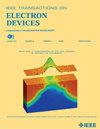探索片厚缩放和基片方向,最大限度地提高纳米片 pFET 性能
IF 2.9
2区 工程技术
Q2 ENGINEERING, ELECTRICAL & ELECTRONIC
引用次数: 0
摘要
我们利用一个考虑到量子禁锢的校准良好的子带 BTE 求解器,探索了 p 型纳米片 FET(NsFET)在片厚度缩放情况下的性能。我们的研究发现,尽管栅极静电增强,但由于声子和表面粗糙度散射(SRS)增加,禁锢 pFET 的空穴迁移率显著降低。研究还发现,在具有理想平坦表面(表面粗糙度极低)的沟道中引入单轴压应力,可将 pFET 的导通电流提高约 2.5 倍。此外,通过在${ 110\}$ 衬底上而不是在传统的${ 100\}$ 衬底上集成 p 型 NsFET,有可能产生更优越的空穴迁移率和整体器件性能,特别是在按比例增加片厚的情况下。本文章由计算机程序翻译,如有差异,请以英文原文为准。
Exploring Sheet Thickness Scaling and Substrate Orientation for Maximizing Nanosheet pFET Performance
We explored the performance of p-type nanosheet FETs (NsFETs) with sheet thickness scaling using a well-calibrated subband BTE solver that accounts for quantum confinement. Our investigation revealed that despite enhancements in gate electrostatics, the confined pFETs exhibit significantly reduced hole mobility due to increased phonon and surface roughness scattering (SRS). It is also found that introducing uniaxial compressive stress into the channel with an ideally flat surface (very low surface roughness) could boost the pFET on-current by approximately 2.5 times. Furthermore, by integrating p-type NsFETs on
$\{ 110\}$
substrate, rather than on conventional
$\{ 100\}$
substrate, it is likely to yield superior hole mobility and overall device performance, particularly at scaled sheet thicknesses.
求助全文
通过发布文献求助,成功后即可免费获取论文全文。
去求助
来源期刊

IEEE Transactions on Electron Devices
工程技术-工程:电子与电气
CiteScore
5.80
自引率
16.10%
发文量
937
审稿时长
3.8 months
期刊介绍:
IEEE Transactions on Electron Devices publishes original and significant contributions relating to the theory, modeling, design, performance and reliability of electron and ion integrated circuit devices and interconnects, involving insulators, metals, organic materials, micro-plasmas, semiconductors, quantum-effect structures, vacuum devices, and emerging materials with applications in bioelectronics, biomedical electronics, computation, communications, displays, microelectromechanics, imaging, micro-actuators, nanoelectronics, optoelectronics, photovoltaics, power ICs and micro-sensors. Tutorial and review papers on these subjects are also published and occasional special issues appear to present a collection of papers which treat particular areas in more depth and breadth.
 求助内容:
求助内容: 应助结果提醒方式:
应助结果提醒方式:


